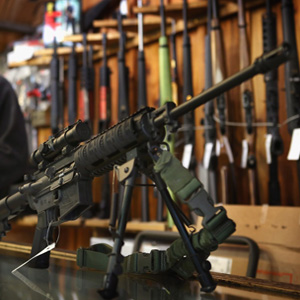The People Have the Right To Keep And Bear Arms of Any Description

On December 13, 2016, in the case no. 16-7165 titled Stephens vs Jerejian, et al, Plaintiff Marc Stephens Petition for Writ of Certiorari was received and docketed by the Supreme Court of the United States. The Attorney General of New Jersey has until January 12, 2017 to file an answer. Stephens is seeking to strike down New Jersey’s Firearm law as facially unconstitutional and in violation of the Second and Fourteenth Amendment of the United States Constitution.
Marc Stephens petition raises multiple arguments, one which includes the people have the right to keep and bear arms of any description.
Marc also raised his legal argument in the United Stated Court of Appeals for the Third Circuit which reads as follow:
The People Have the Right To Keep And Bear Arms Of Any Description
Heller states, In Nunn v. State, 1 Ga. 243, 251 (1846) “Its opinion perfectly captured the way in which the operative clause of the Second Amendment furthers the purpose announced in the prefatory clause, in continuity with the English right:
"The right of the whole people, old and young, men, women and boys, and not militia only, to keep and bear arms of every description, and not such merely as are used by the militia, shall not be infringed, curtailed, or broken in upon, in the smallest degree; and all this for the important end to be attained: the rearing up and qualifying a well-regulated militia, so vitally necessary to the security of a free State. Our opinion is, that any law, State or Federal, is repugnant to the Constitution, and void, which contravenes this right, originally belonging to our forefathers, trampled under foot by Charles I. and his two wicked sons and successors, re-established by the revolution of 1688, conveyed to this land of liberty by the colonists, and finally incorporated conspicuously in our own Magna Charta!" Id at 2809.
“It may be objected that if weapons that are most useful in military service—M-16 rifles and the like—may be banned, then the Second Amendment right is completely detached from the prefatory clause. But as we have said, the conception of the militia at the time of the Second Amendment's ratification was the body of all citizens capable of military service, who would bring the sorts of lawful weapons that they possessed at home to militia duty. It may well be true today that a militia, to be as effective as militias in the 18th century, would require sophisticated arms that are highly unusual in society at large. Indeed, it may be true that no amount of small arms could be useful against modern-day bombers and tanks. But the fact that modern developments have limited the degree of fit between the prefatory clause and the protected right cannot change our interpretation of the right”. Id at 2817.
("A statute which, under the pretence of regulating, amounts to a destruction of the right, or which requires arms to be so borne as to render them wholly useless for the purpose of defence, would be clearly unconstitutional", State v. Reid, 1 Ala. 612, 616-617 (1840)). Id at 2818.
“A right deemed fundamental carries with it an implicit and inherent recognition of its necessity to a free people. States have no compelling (or even legitimate) interest in depriving people of their constitutional rights, and the State cannot point to the impact of its practice – the suppression of constitutional rights – as its interest”. See Simon & Schuster, Inc. v. N.Y. State Crime Victims Bd., 502 U.S. 105, 120 (1991).
“We expressly rejected the argument that the scope of the Second Amendment right should be determined by judicial interest balancing”, 554 U.S., at ___ - ___, 128 S.Ct., at 2820-2821, McDonald v. City of Chicago, Ill., 130 S. Ct. 3020 - Supreme Court 2010 at 3047.
No matter how laudable the end, the Supreme Court has long made clear that the Constitution disables the government from employing certain means to prevent, deter, or detect violent crime. See, e.g., United States v. Jones, 132 S. Ct. 945 (2012); Kennedy v. Louisiana, 554 U.S. 407 (2008); Kyllo v. United States, 533 U.S. 27 (2001); Miranda v. Arizona, 384 U.S. 436 (1966); Mapp v. Ohio, 367 U.S. 643 (1961); see also Heller II, 670 F.3d at 1296 (Kavanaugh, J., dissenting).
Copy of Marc Stephens' Petition for Writ of Certiorari to the Supreme Court of the United States
Marc also raised his legal argument in the United Stated Court of Appeals for the Third Circuit which reads as follow:
The People Have the Right To Keep And Bear Arms Of Any Description
Heller states, In Nunn v. State, 1 Ga. 243, 251 (1846) “Its opinion perfectly captured the way in which the operative clause of the Second Amendment furthers the purpose announced in the prefatory clause, in continuity with the English right:
"The right of the whole people, old and young, men, women and boys, and not militia only, to keep and bear arms of every description, and not such merely as are used by the militia, shall not be infringed, curtailed, or broken in upon, in the smallest degree; and all this for the important end to be attained: the rearing up and qualifying a well-regulated militia, so vitally necessary to the security of a free State. Our opinion is, that any law, State or Federal, is repugnant to the Constitution, and void, which contravenes this right, originally belonging to our forefathers, trampled under foot by Charles I. and his two wicked sons and successors, re-established by the revolution of 1688, conveyed to this land of liberty by the colonists, and finally incorporated conspicuously in our own Magna Charta!" Id at 2809.
“It may be objected that if weapons that are most useful in military service—M-16 rifles and the like—may be banned, then the Second Amendment right is completely detached from the prefatory clause. But as we have said, the conception of the militia at the time of the Second Amendment's ratification was the body of all citizens capable of military service, who would bring the sorts of lawful weapons that they possessed at home to militia duty. It may well be true today that a militia, to be as effective as militias in the 18th century, would require sophisticated arms that are highly unusual in society at large. Indeed, it may be true that no amount of small arms could be useful against modern-day bombers and tanks. But the fact that modern developments have limited the degree of fit between the prefatory clause and the protected right cannot change our interpretation of the right”. Id at 2817.
("A statute which, under the pretence of regulating, amounts to a destruction of the right, or which requires arms to be so borne as to render them wholly useless for the purpose of defence, would be clearly unconstitutional", State v. Reid, 1 Ala. 612, 616-617 (1840)). Id at 2818.
“A right deemed fundamental carries with it an implicit and inherent recognition of its necessity to a free people. States have no compelling (or even legitimate) interest in depriving people of their constitutional rights, and the State cannot point to the impact of its practice – the suppression of constitutional rights – as its interest”. See Simon & Schuster, Inc. v. N.Y. State Crime Victims Bd., 502 U.S. 105, 120 (1991).
“We expressly rejected the argument that the scope of the Second Amendment right should be determined by judicial interest balancing”, 554 U.S., at ___ - ___, 128 S.Ct., at 2820-2821, McDonald v. City of Chicago, Ill., 130 S. Ct. 3020 - Supreme Court 2010 at 3047.
No matter how laudable the end, the Supreme Court has long made clear that the Constitution disables the government from employing certain means to prevent, deter, or detect violent crime. See, e.g., United States v. Jones, 132 S. Ct. 945 (2012); Kennedy v. Louisiana, 554 U.S. 407 (2008); Kyllo v. United States, 533 U.S. 27 (2001); Miranda v. Arizona, 384 U.S. 436 (1966); Mapp v. Ohio, 367 U.S. 643 (1961); see also Heller II, 670 F.3d at 1296 (Kavanaugh, J., dissenting).
Copy of Marc Stephens' Petition for Writ of Certiorari to the Supreme Court of the United States

